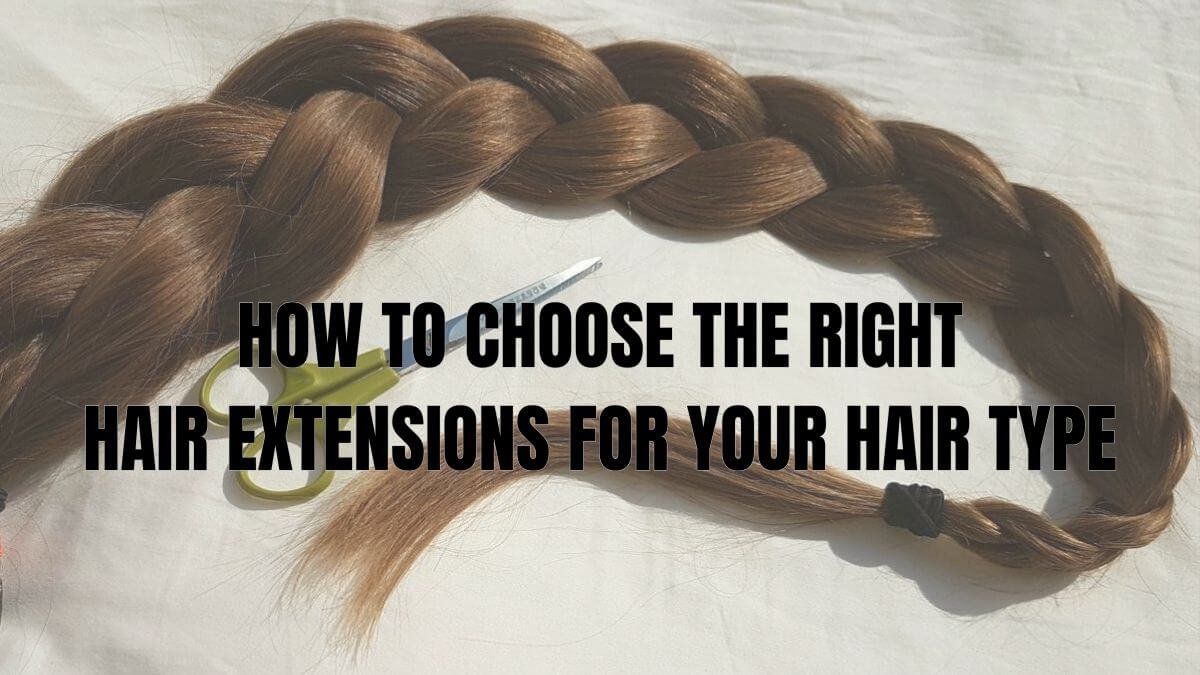Find the right hair extensions for your hair type, whether thin, thick, curly, or damaged. Get expert tips for a natural-looking blend.
The right hair extensions can enhance your hair’s volume, length, and style. Nevertheless, not all extensions fit every hair type. If you experience discomfort, poor blending, or hair damage, it’s a sign you’ve chosen the wrong type. The key here is to pick good extensions that go with your hair, texture, thickness, and general health.
In this guide, we’ll explore the best hair extensions for your hair type and provide expert tips to help you make the right choice.
1. Best hair extensions for each hair type
Explore the specific types of hair extensions that are right for you:
1.1. Thin/fine hair
Thin or fine hair has fewer strands per square inch and tends to be more delicate. Choose lightweight extensions that add volume without putting excessive tension on your roots. If you have thin or fine hair, opt for lightweight extensions that won’t stress the roots.
Best options for thin/fine hair:
- Tape-in extensions: Lightweight and blend well with fine hair without adding bulk.
- Halo extensions: A damage-free option that sits on the head like a headband that does not pull on natural hair.
- Nano-bead extensions: Tiny and lightweight, making them ideal for fine hair.
What you should avoid is heavy clip-in extensions as they can cause stress on fine hair.
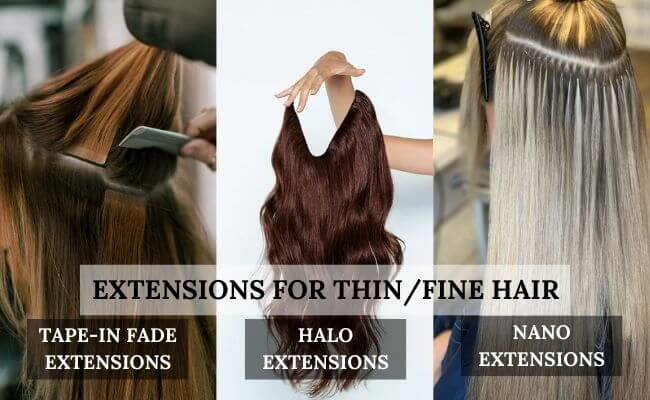
1.2. Extensions for thick/coarse hair
Hair with high density and a rough texture is considered thick or coarse. It’s more capable of heavier extensions and needs durable ones that complement its natural volume. Thick, coarse hair needs strong, durable extensions that match its natural density.
Best options for thick/coarse hair:
- Weave (sew-in) extensions: Ideal for adding volume and work best with dense hair.
- Clip-in extensions: Easy-to-use clip-in extensions for instant volume with less tension than other types of extensions.
- Keratin bond extensions: Blend well with coarse hair and offer a long-lasting, natural appearance.
What you should avoid is halo extensions as they’re too lightweight and may not feel secure in thick hair.
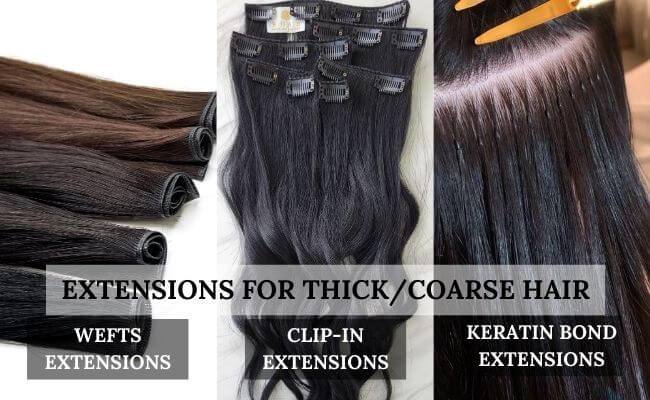
1.3. Extensions for curly/wavy hair
Curly or wavy hair has natural movement and texture, so your extensions should match the curl pattern for a natural look. When wearing extensions for curly, wavy, or curly-wavy hair, curls should match the natural curl pattern.
Best options for curly/wavy hair:
- Wefts or hand-tied extensions: These extensions are for natural curls and a blend that will maintain curl structure and blend naturally.
- Tape-in extensions: Wavy textures work well with tape-in extensions and have a natural finish.
- I-tip extensions: A great semi-permanent with curly hair integration.
What you should avoid is bone straight extensions as they will not blend well with naturally wavy or curly hair.
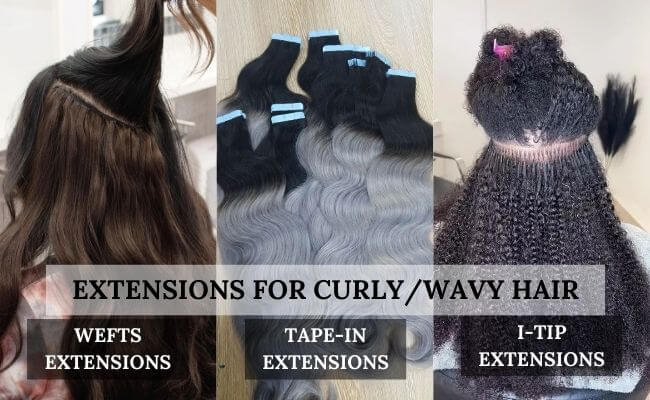
1.4. Extensions for straight hair
Straight hair needs extensions that add volume and length while maintaining a sleek, natural look. It is a good match for extensions to straight hair to give it volume while keeping it sleek.
Best options for straight hair:
- Clip-in extensions: Excellent for adding volume and length in minutes, clip-in extensions.
- Tape-in extensions: Blend seamlessly with straight hair for a natural finish.
- Keratin-bond extensions: Long-lasting and great for wanting a semi-permanent solution, keratin bond extensions.
What you should avoid is thick-textured or extremely curly extensions as they will look unnatural when blended with straight hair.
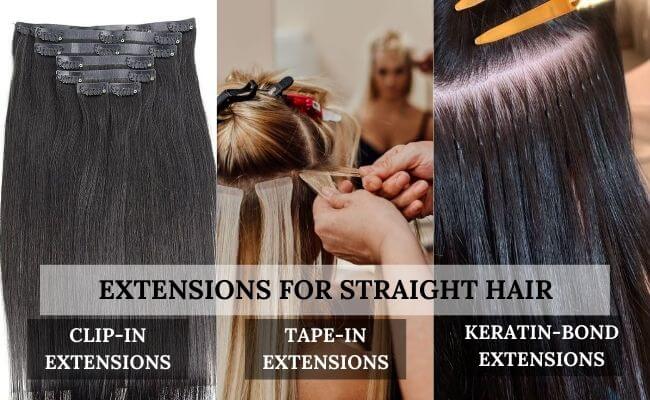
1.5. Extensions for damaged or fragile hair
Hair can become fragile or damaged from excessive styling or chemical treatments. It requires lightweight, non-damaging extensions that won’t stress the hair and can support recovery. If your hair is weak or damaged, you need to pay attention to extensions that cause as little stress as possible.
Best options for damaged or fragile hair:
- Halo extensions: Damage-free as they don’t have a direct adhesion to your hair.
- Lightweight tape-in extensions: This is a gentle option for distributing the weight evenly.
- Wigs or toppers: A protective method, wigs or toppers, that do not interfere with the recovery of your natural hair.
What you should avoid are heavy or permanently bonded extensions as they can add excess stress to hair.
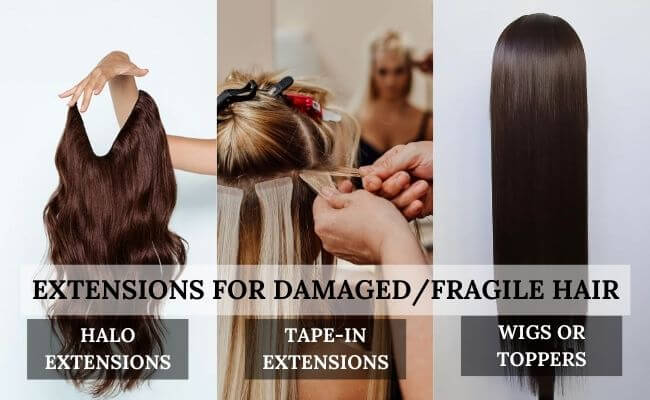
2. Tips for choosing the right extensions
Consider the texture, length, and color of the extensions before making your choice. Moreover, the best extensions are real human hair.
2.1. Texture, length, and color
To achieve a flawless blend, choose extension color, length, and texture to match your natural hair.
- Texture: Choose an extension that offers an extension that resembles your natural hair type (straight, wavy, curly, or coily).
- Avoid overly long extensions if you’re not ready for the extra maintenance.
- For a highlighted look, consider balayage or ombre extensions that closely match your natural shade.
2.2. High-quality, real human hair
100% human hair extensions are the best because of their longevity and styling flexibility.
- Unlike synthetic alternatives, human hair extensions can be styled with heat and dyed as desired.
- They blend seamlessly with your hair and offer a natural look and feel.
- With proper care, they can last longer (up to 3-5 years) thus it is worth the investment.
Synthetic or low-quality blends should be avoided because they tangle easily, are not heat resistant, and have a shorter lifespan.
Conclusion
Choosing the right hair extensions depends on understanding your hair type and selecting extensions that match its texture, density, and condition. Whether your hair is fine, thick, curly, straight, or fragile, there’s a perfect option out there that blends seamlessly and enhances your natural beauty.

